笔记本电脑
| 这是Junjie Yuan的用户沙盒。用户沙盒是用户页的子页面,属于用户的测试区,不是维基百科条目。 公用沙盒:主沙盒 | 使用指南沙盒一、二 | 模板沙盒 | 更多…… 此用户沙盒的子页面: 外观选项: 用字选项: 如果您已经完成草稿,可以请求志愿者协助将其移动到条目空间。 |
翻译状态:施工中······(译自835641215)
此条目需要补充更多来源。 (2008年10月12日) |
| “笔记本电脑”的各地常用名称 | |
|---|---|
 一台苹果的MacBook Pro 笔记本 | |
| 中国大陆 | 笔记本电脑(笔记本) |
| 台湾 | 笔记型电脑(笔电) |
| 港澳 | 手提电脑 |

笔记本电脑(英语:Notebook Computer,简称为:Notebook PC、Notebook、NB),中文又称笔记型、手提或膝上电脑(英语:Laptop Computer,可简为Laptop)其中Notebook,笔记型一称只在中文区比较通行,其他地区如英美日较常用Laptop,是一种小型、可以方便携带的个人电脑,通常重达1至3公斤,亦有不足1公斤者。最早商业化销售的现代笔记本电脑是PowerBook 100。[来源请求]此前的世界第一台便携式电脑Macintosh Portable体形巨大,并不受消费者欢迎。现在的发展趋势是体积越来越小,重量越来越轻,而功能却越发强大。为了缩小体积,笔记型电脑通常拥有液晶显示器(液晶屏),现在新型的部分机种甚至有触屏。除了键盘以外,还装有触摸板(touchpad)或触控点作为定位装置(Pointing device)。
就现在来看,笔记本电脑从用途上一般可以分为4类:商务型、时尚型、多媒体应用、特殊用途。商务型笔记本电脑的特征一般可以概括为移动性强、电池续航时间长;时尚型外观特异也有适合商务使用的时尚型笔记本电脑;多媒体应用型的笔记本电脑是结合强大的图形及多媒体处理能力又兼有一定的移动性的综合体,市面上常见的多媒体笔记本电脑拥有独立的较为先进的显卡,较大的屏幕等特征;特殊用途的笔记本电脑是服务于专业人士,可以在酷暑、严寒、低气压、战争等恶劣环境下使用的机型,多较笨重[来源请求]。
历史
[编辑]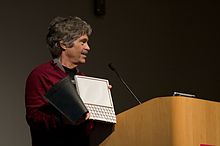
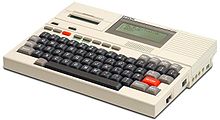
随着个人电脑(PC)在1971年变得可行,便携式个人电脑的想法亦随之而来。1968年,Alan Kay在Xerox PARC设想了一种“个人便携式资讯操纵器”,[1] 并在其1972年的论文中称其为“Dynabook”。.[2] IBM于1973年进行了演示特殊电脑便携式APL机器(SCAMP),该原型基于IBM PALM处理器。[3] 于1975年9月出现发布的IBM 5100是第一台商用便携式电脑,其基于SCAMP原型。[4]
随着8位CPU机器的普及,便携机的数量迅速增加。The first laptop-sized notebook computer was the Epson HX-20,[5][6] invented (patented) by Suwa Seikosha's Yukio Yokozawa in July 1980,[7] introduced at the COMDEX computer show in Las Vegas by Japanese company Seiko Epson in 1981,[8][6] and widely released in 1982.[6][9] It had an LCD screen, a rechargeable battery, and a calculator-size printer, in a 1.6千克(3.5磅) chassis, the size of an A4 notebook.[6] It was described as a "laptop" and "notebook" computer in its patent.[7]
The portable micro computer Portal of the French company R2E Micral CCMC officially appeared in September 1980 at the Sicob show in Paris. It was a portable microcomputer designed and marketed by the studies and developments department of R2E Micral at the request of company CCMC specializing in payroll and accounting. It was based on an Intel 8085 processor, 8-bit, clocked at 2 MHZ. It was equipped with a central 64K bite Ram, a keyboard with 58 alpha numeric keys and 11 numeric keys ( separate blocks ), a 32-character screen, a floppy disk : capacity = 140 000 characters, of a thermal printer : speed = 28 characters / second, an asynchronous channel, a synchronous channel, a 220V power supply. It weighed 12 kg and its dimensions were 45cm x 45cm x 15cm. It provided total mobility. Its operating system was the aptly named Prologue.

The Osborne 1, released in 1981, was a luggable computer that used the Zilog Z80 and weighed 24.5英磅(11.1千克).[10] It had no battery, a 5英寸(13 cm) cathode ray tube (CRT) screen, and dual 5.25英寸(13.3 cm) single-density floppy drives. Both Tandy/RadioShack and Hewlett Packard (HP) also produced portable computers of varying designs during this period.[11][12] The first laptops using the flip form factor appeared in the early 1980s. The Dulmont Magnum was released in Australia in 1981–82, but was not marketed internationally until 1984–85. The US$8,150 (US$25,730 today) GRiD Compass 1101, released in 1982, was used at NASA and by the military, among others. The Sharp PC-5000,[13] Ampere[14] and Gavilan SC released in 1983. The Gavilan SC was described as a "laptop" by its manufacturer,[15] while the Ampere had a modern clamshell design.[14][16] The Toshiba T1100 won acceptance not only among PC experts but the mass market as a way to have PC portability.[17]
From 1983 onward, several new input techniques were developed and included in laptops, including the touchpad (Gavilan SC, 1983), the pointing stick (IBM ThinkPad 700, 1992), and handwriting recognition (Linus Write-Top,[18] 1987). Some CPUs, such as the 1990 Intel i386SL, were designed to use minimum power to increase battery life of portable computers and were supported by dynamic power management features such as Intel SpeedStep and AMD PowerNow! in some designs.
Displays reached 640x480 (VGA) resolution by 1988 (Compaq SLT/286), and color screens started becoming a common upgrade in 1991, with increases in resolution and screen size occurring frequently until the introduction of 17" screen laptops in 2003. Hard drives started to be used in portables, encouraged by the introduction of 3.5" drives in the late 1980s, and became common in laptops starting with the introduction of 2.5" and smaller drives around 1990; capacities have typically lagged behind physically larger desktop drives. Optical storage, read-only CD-ROM followed by writeable CD and later read-only or writeable DVD and Blu-ray players, became common in laptops early in the 2000s.
基本组成
[编辑]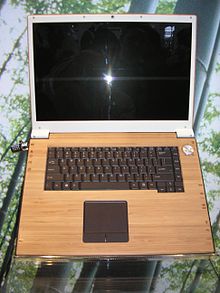
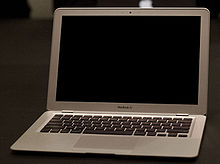
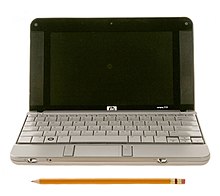

- 外壳:外壳除了美观外相对于台式计算机更起到对于内部器件的保护作用。较为流行的外壳材料有:工程塑料、镁铝合金、碳纤维复合材料(碳纤维复合塑料)。其中碳纤维复合材料的外壳兼有工程塑料的低密度高延展及镁铝合金的刚度与屏蔽性,是较为优秀的外壳材料。一般硬件供应商所标示的外壳材料是指笔记本电脑的上表面材料,托手部分及底部一般习惯使用工程塑料。
- 液晶屏幕:笔记本电脑从诞生之初就开始使用液晶屏作为其标准输出装置,其分类大致有:STN、薄膜晶体管液晶显示器(TFT)等。现今民用级别的液晶屏较为优秀的有夏普公司的“超黑晶”,东芝公司的“低温多晶硅”和苹果公司的高分辨率“Retina显示屏”等。这几款都是薄膜晶体管液晶显示器液晶屏,其中苹果的Retina显示屏还使用了IPS技术。除了屏幕外液晶屏的发光装置也是非常的重要,质量较差的灯管会使得液晶屏的色温偏差非常的严重(主要是发黄或者发红)。
- 中央处理器(CPU):CPU是个人电脑的核心装置,笔记本电脑也不例外。和台式计算机不同,笔记本电脑的CPU除了速度等性能指标外还要兼顾功耗。不但CPU本身便是能耗大户,由于温度升高而升高的笔记本电脑的整体散热系统的能耗也不能忽视。
- 散热系统:笔记本电脑的散热系统由导热装置和散热装置组成,其基本原理是由导热装置(现在一般使用热管)将热量集中到散热装置(现在一般使用散热片及风扇,也有使用水冷系统的型号)散出。少为人知的散热装置还有键盘,在敲打之间键盘也将散去大量的热量。不过,由于笔记本电脑散热系统非常细小,用久了容易积满灰尘,导致散热系统性能减退,风扇噪音增加,严重更会令风扇停顿,导致CPU过热。所以笔记本电脑散热系统是要不时打理。
- 定位装置(Pointing device):笔记本电脑一般会在机身上搭载一套定位装置(相当于台式计算机的滑鼠,也有搭载两套定位装置的型号),早期一般使用轨迹球作为定位装置,现在较为流行的是触控板(Touchpad)与指点杆。由于Windows 8特别强化适用于触摸屏的平板电脑设计,所以一部分笔记本电脑开始增加触摸屏作为新的定位装置。
参见
[编辑]参考文献
[编辑]- ^ John W. Maxwell. Tracing the Dynabook: A Study of Technocultural Transformations (PDF). 2006 [17 October 2008]. (原始内容 (PDF)存档于24 January 2007).
- ^ Alan C. Kay. A Personal Computer for Children of All Ages (PDF). 1972 [17 October 2008].
- ^ IBM Personal Computer. IBM Inc.
- ^ IBM 5100 computer. oldcomputers.net. [6 July 2009].
- ^ Epson SX-20 Promotional Brochure (PDF). Epson America, Inc. 1987 [2 November 2008].
- ^ 6.0 6.1 6.2 6.3 【Shinshu Seiki / Suwa Seikosha】 HC-20, Information Processing Society of Japan
- ^ 7.0 7.1 FR2487094A1 patent: Notebook computer system small
- ^ Epson HX-20, Old Computers
- ^ Michael R. Peres, The Focal Encyclopedia of Photography, page 306, Taylor & Francis
- ^ Osborne 1, Old Computers
- ^ Tandy/Radio Shack model 100 portable computer. oldcomputers.net. [6 July 2009].
- ^ Hewlett-Packard model 85. oldcomputers.net. [6 July 2009].
- ^ Sharp PC-5000, Old Computers
- ^ 14.0 14.1 Bob Armstrong, http://cosy.com/language/cosyhard/cosyhard.htm
- ^ Gavilian SC computer. oldcomputers.net. [7 July 2009].
- ^ Japanese PCs (1984) (13:13), Computer Chronicles
- ^ Milestones:Toshiba T1100, a Pioneering Contribution to the Development of Laptop PC, 1985
- ^ Linus Write-Top. [18 October 2008].
外部链接
[编辑]
